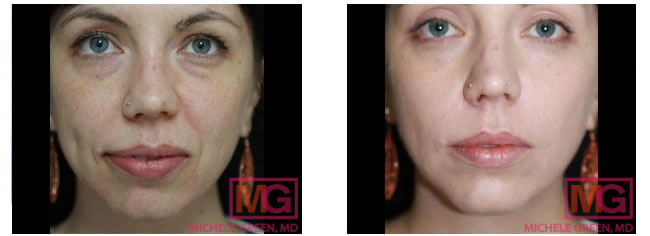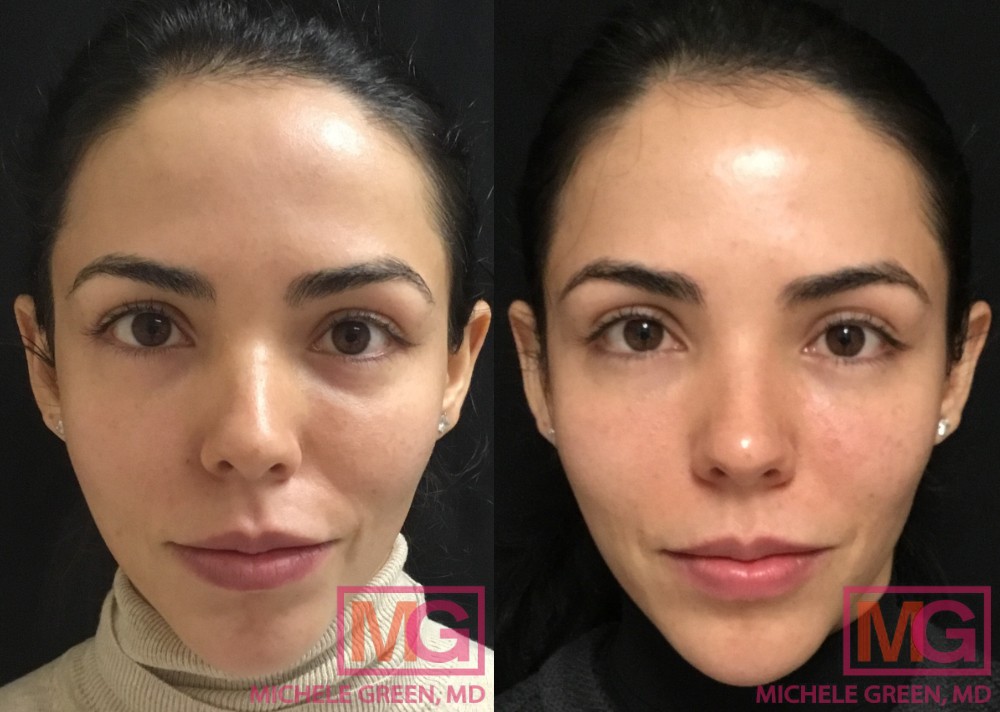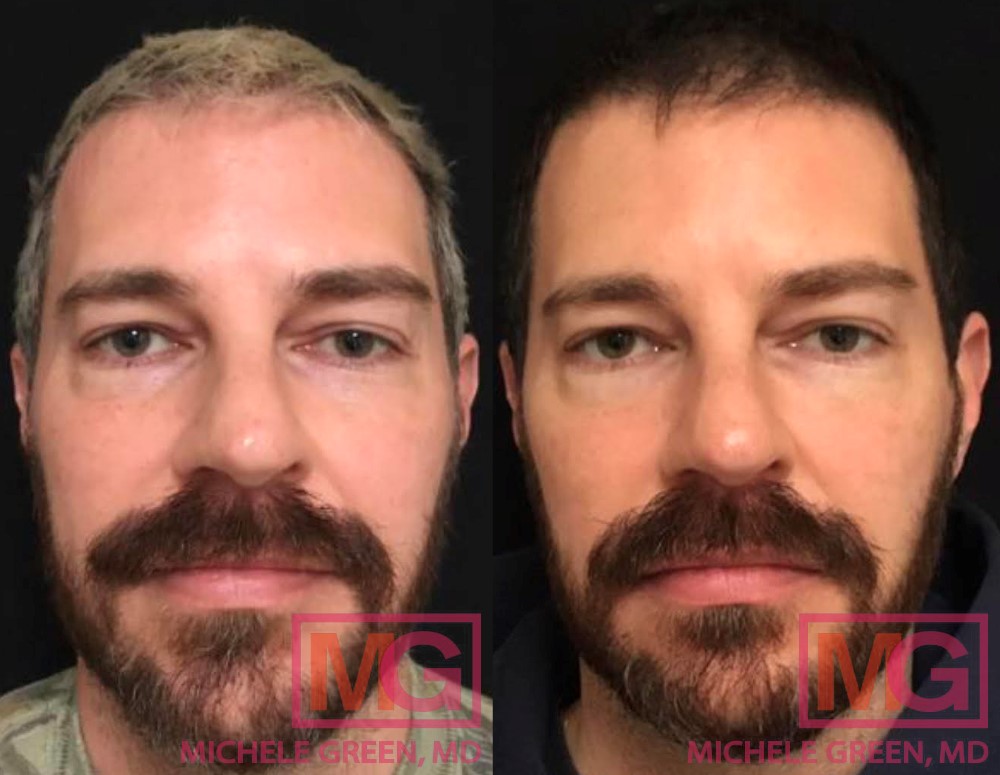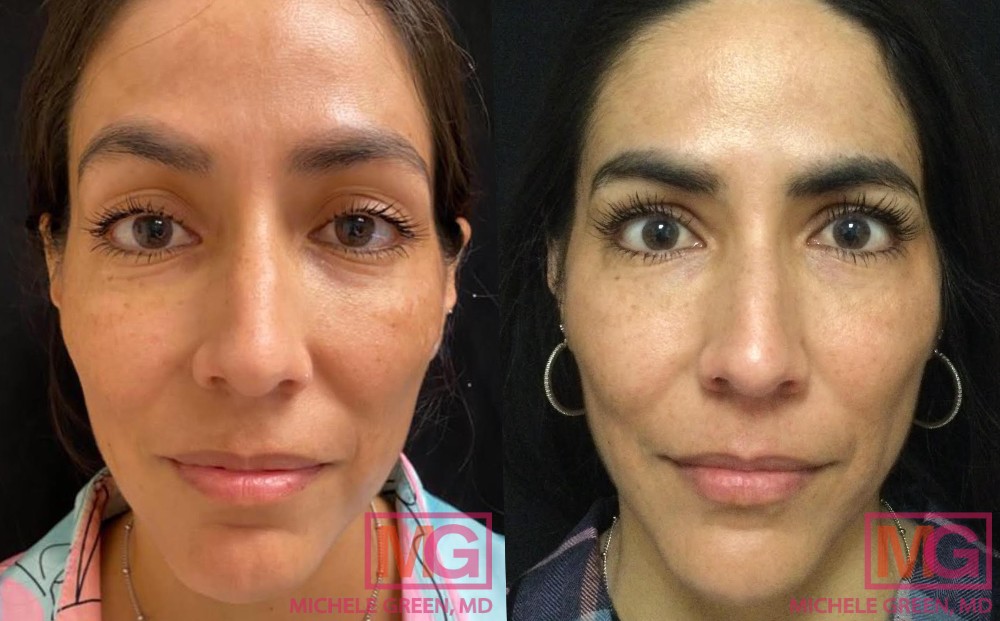Tear Trough Fillers
Dark circles, eye bags, under-eye hollows, fine lines, and puffiness around the eyes can make us appear significantly older than we are. For many individuals, these signs of aging and exhaustion can adversely affect self-esteem. Tear trough fillers are a non-invasive cosmetic treatment option for revitalizing the under-eye area. A tear trough refers to a crease in the under-eye area that may appear sunken or hollow, creating a tired, worn-out look that often worsens with age. Tear trough filler injections are placed between the lower eyelid and upper cheek to restore volume and smooth out the under-eye hollows that can cast shadows, resulting in the appearance of dark circles. If you’re seeking a solution for tired-looking under-eyes that doesn’t involve plastic surgery, Dr. Green is ready to assist. At her private dermatology office in Manhattan’s Upper East Side neighborhood, Dr. Green provides her patients with access to a variety of non-invasive cosmetic procedures for rejuvenation, including under-eye fillers, Botox, laser treatments, microneedling, various dermal fillers, chemical peels, and more.
Undereye fillers are ideal for patients seeking to refresh their eyes without the downtime or risks associated with plastic surgery. The most effective fillers for the under-eye area include hyaluronic acid options such as Juvederm, Restylane, or Belotero. These fillers restore volume and hydration in the tear troughs, correcting hollowness. Patients appreciate that, as a non-surgical treatment option, tear trough fillers deliver natural-looking, long-lasting rejuvenation results with no downtime and minimal potential side effects. To ensure safety, efficacy, and optimal outcomes, dermal fillers should always be administered by an experienced medical professional, such as board-certified dermatologist Dr. Michele Green in NYC. Dr. Green is an expert injector who can collaborate with you to assess your candidacy for tear trough fillers and create a personalized treatment plan that addresses your unique skincare concerns and aesthetic goals, helping you look and feel like the best version of yourself.
Dr. Michele Green is a world-renowned expert in cosmetic dermatology with over 25 years of experience treating discerning patients from around the globe for a myriad of skin concerns, including dark under-eyes, sun damage, fine lines, and wrinkles, hyperpigmentation, acne, and acne scars. She is consistently rated as a top NYC dermatologist by Castle Connolly, Super Doctors, New York Magazine, and The New York Times due to her expertise and dedication to her patients. Dr. Green employs a holistic approach to cosmetic dermatology and embraces a ‘less is more’ philosophy to achieve beautiful, natural-looking results. When you collaborate with Dr. Green to treat your under-eye area, you can trust that you have a provider with the skill and knowledge to deliver phenomenal, natural-looking, long-lasting cosmetic results. During your consultation, Dr. Green will evaluate your under-eye hollows to select the right tear trough filler for you, ensuring a rejuvenated, youthful-looking under-eye area.
What is tear trough filler?
The tear trough is an area of the face, the hollow located between the upper cheek and the lower eyelid. It is sometimes referred to as the nasojugal hollow. Tear troughs can cast a shadow and create the appearance of a darkened under-eye area, making one look tired or prematurely aged. They can be genetic, but they may be present due to the natural loss of collagen that occurs as we age. Reduced collagen levels in the under-eye area lead to transparent, thin skin, increasing the visibility of underlying blood vessels and creating a darkened under-eye area.
A dermal filler is a cosmetic product intended for injection into soft tissue, producing an anti-aging effect while enhancing or contouring facial features. These fillers come in a wide range of formulations and styles, allowing patients to achieve full facial rejuvenation. Whether a patient wants to diminish the appearance of under-eye hollows, add volume to naturally thin lips, or achieve a more youthful cheek or defined jawline, dermal fillers can help. Dermal fillers are a non-invasive cosmetic treatment, which means there is essentially no downtime associated with them, unlike traditional plastic surgery procedures.
Tear trough filler involves the injection of hyaluronic acid under the eyes. The hyaluronic acid gel immediately adds volume to the skin and provides more moisture, restoring a youthful appearance in the treatment area. Each family of dermal filler has slightly different properties, and no family is inherently better than the other. During your initial consultation with Dr. Green, she will determine the filler or combination of fillers that works best for your specific needs.
What does tear-trough filler do?
Tear trough fillers restore lost volume in the nasojugal fold beneath the eyes and enhance the appearance of dark circles and under-eye bags. Various hyaluronic dermal fillers, such as Belotero, Restylane, and Juvederm, can help correct this tear-trough deformity. These fillers are specifically designed to replenish volume in the treated area. When injected into the tear trough region, dermal fillers reduce the look of dark circles and shadows under the eyes caused by volume loss. While dermal fillers cannot correct skin discoloration, they can minimize the shadowing that makes the area appear darker by adding volume. The preferred fillers for this area are made from hyaluronic acid gel with a small particle size. Hyaluronic acid is a substance naturally produced by the body that helps plump the skin and boosts collagen production, resulting in a more youthful complexion. Using dermal fillers to treat the under-eye area can provide natural-looking volume restoration while minimizing the appearance of fine lines, puffiness, and dark circles.

Before and after 1 syringe of Restylane in Tear Troughs (under eyes)
Which dermal filler works best for tear troughs
Dr. Green often uses hyaluronic acid-based fillers such as Restylane-L, Restylane Eyelight, Juvederm Volbella, and Belotero Balance to correct undereye hollowing. Hyaluronic acid (HA) is a natural component of the skin that supplies it with hydration, keeping the skin plump and supple. HA fillers work to restore lost volume and hydration in the tear troughs to correct tired-looking eyes and under-eye bags. These specific fillers have a soft formulation to enhance your natural appearance for a rejuvenated look.
Restylane-L was the original Restylane filler used to correct various signs of aging. It corrects moderate facial wrinkles around the mouth and tear trough area, subtle, natural-looking lip enhancement, and acne scars. Cosmetic results can last for six to nine months.
Restylane Eyelight is a newer dermal filler that was FDA-approved in 2023 for use under the eyes. It is commonly used to improve the appearance of hollowing and under-eye bags. Restylane can help restore lost volume in the tear trough area and reduce the appearance of fine lines and wrinkles in the treatment area. This dermal filler uses crosslinking and patented NASHA technology to erase under-eye hollowing and dark circles caused by lost volume.
Juvederm Volbella was the first FDA-approved dermal filler for treating tear troughs, gaining approval in 2016. Its thin formulation is the thinnest in the Juvederm family, allowing it to be easily placed in the delicate undereye hollows. The dermal filler’s patented VyCross technology allows for smooth and even distribution under the skin.
Belotero Balance offers a soft and even correction in the skin, making it highly effective for addressing tear troughs. Belotero features an ultra-thin and flexible formulation that helps prevent a side effect known as the Tyndall effect. This effect can create a bluish hue in the injected area due to the reflection of light off particles suspended in the filler. With its small particle size and thin formulation, Belotero reduces the risk of the bluish hue associated with the Tyndall effect.
The best filler for tear troughs will depend on your facial anatomy, skin concerns, and cosmetic goals. When you consult with Dr. Green, she will assess you in person to determine which dermal filler is most appropriate for you.
Who is a good candidate for under-eye filler treatment?
Tear trough fillers are an excellent option for rejuvenating the under-eye area; however, not everyone is a candidate for the procedure. The ideal candidate for dermal filler injections in the tear trough is a healthy individual with mild to moderate volume loss in the under-eye area. If there is excessive wrinkling or skin under the eyes with fat deposits, tear trough fillers may not be the most suitable treatment. Additionally, some patients have dark circles due to excess pigment in the skin rather than volume loss, which may not be addressed with filler. During your consultation with Dr. Green, she will evaluate your under-eye area to determine if tear trough fillers are the right treatment for you or if another cosmetic procedure may be better suited. If you are not a suitable candidate for tear trough fillers or other non-invasive cosmetic treatment options, Dr. Green will refer you to a trusted board-certified plastic surgeon for a surgical consultation.

How does the undereye filler procedure work?
The process of getting tear trough fillers is very straightforward. First, you will schedule a consultation with board-certified dermatologist Dr. Michele Green at her private office on the Upper East Side. During this consultation, she will review your medical history, facial anatomy, skin concerns, and aesthetic goals to confirm your suitability for under-eye fillers and develop a personalized treatment plan for rejuvenating your eyes. Medical photography will be taken to monitor the future progress of your treatment. Dr. Green will explain the recommended treatments, including the number of syringes and the specific type of dermal filler needed.
On the day of your procedure, you will apply a topical numbing cream to the under-eye area one hour before your injections. When you arrive at Dr. Green’s private dermatology office in NYC for your dermal filler treatments, the treatment area will be cleaned and prepared for injections. Dr. Green uses very small needles or cannulas to inject fillers into the tear troughs, employing a gentle technique to minimize bruising and discomfort. Immediately after the injections, ice packs will be applied to the treatment area to help reduce swelling and bruising. On the day of your appointment, Dr. Green will provide aftercare instructions. Additionally, Dr. Green may ask you to return in two weeks to evaluate the results and determine if a touch-up is necessary.
Is tear trough filler safe?
Yes! When performed by an experienced injector, tear trough filler is safe with a few mild side effects. There typically are no major side effects associated with receiving under-eye fillers. However, some swelling and bruising at or around the injection site are common side effects that can occur. Icing immediately after injections will minimize any swelling or redness that occurs. Bruising is another potential side effect of tear-trough fillers. To decrease bruising, Dr. Green recommends discontinuing blood-thinning medications and supplements, including Aspirin, Ibuprofen, Motrin, Advil, and Vitamin E, prior to their filler treatment. Additionally, patients prone to bruising can take Arnica Forte, an herbal supplement, to help prevent and heal bruises faster.
What are the side effects of undereye filler injections?
Undereye filler treatment is safe, especially in the hands of an expert injector like Dr. Green. Some of the most common side effects from treatment include:
- Bruising
- Redness
- Swelling
- Nodule formation
- Pain
- Localized infection
If lumps or nodules appear and do not resolve on their own, patients should return to their injector for evaluation. Hyaluronic acid fillers such as Juvederm, Restylane, and Belotero can be dissolved with hyaluronidase injections. Although rare, allergic reactions can be severe, so it is crucial to disclose your complete medical history and any allergies to your injector before treatment. When dermal fillers are improperly administered, more serious side effects can occur, including blindness, stroke, and skin necrosis if the filler is injected into a blood vessel, also known as an occlusion. The Tyndall Effect is a rare side effect resulting in skin discoloration, which can occur after hyaluronic acid filler injections. The injection area can appear blue if the hyaluronic acid filler is injected too superficially. The color change is temporary, typically lasting several months, but it can be reversed quickly with hyaluronidase injections, which dissolve dermal fillers. It is vital to choose a board-certified dermatologist like Dr. Green in NYC, who possesses the knowledge and expertise to administer your tear trough fillers safely and effectively.

Under eye-filler versus other eye treatments
Some patients present with fine lines and dark circles due to volume loss, while others exhibit increased pigmentation in the undereye area. Dr. Green will collaborate with you to establish an anti-aging treatment plan that addresses the specific factors contributing to the aged appearance of the undereye area. While many non-invasive treatment options exist for eye rejuvenation, sometimes surgery is necessary to correct cosmetic concerns. Popular eye rejuvenation treatments include undereye fillers, eMatrix laser, mesopeel periocular, and blepharoplasty.
Under-eye fillers are a non-invasive cosmetic procedure that uses dermal fillers to restore lost volume and correct hollowing in the under-eye area. Under-eye fillers are not permanent, typically lasting 6 – 9 months, and are associated with little side effects and downtime. Tear trough filler treatment benefits those who want immediate results, don’t want any downtime, and understand that fillers are not a permanent solution.
The eMatrix laser utilizes radiofrequency energy to enhance collagen production. It features a specialized tip designed for the sensitive under-eye area. The eMatrix treatment for this region improves skin texture and tone by stimulating the production of new collagen and elastin, rejuvenating the eyes in just a few treatment sessions. Three sessions, spaced a month apart, will diminish the appearance of fine lines, mild to moderate wrinkles under the eyes, and crow’s feet. The procedure requires minimal downtime, allowing you to return to work immediately after the laser treatment treatment.
The Mesopeel Periocular peel is a gentle treatment that is safe for the delicate skin around the eyes. This unique chemical peel consists of azelaic acid, salicylic acid, lactic acid, resorcinol, citric acid, and phytic acid. It is specially formulated to address concerns in the periorbital area, helping to reduce hyperpigmentation, under-eye circles, and loss of brightness. For those with tired-looking eyes seeking a non-surgical method to enhance their appearance, the Mesopeel Periocular offers an excellent solution for eye rejuvenation.
Blepharoplasty is a type of eyelid surgery performed by a plastic surgeon that enhances the appearance of the upper or lower eyelids by removing excess tissue around them. It can address excess skin, drooping eyelids, under-eye bags, puffiness, and dark circles. This surgical procedure involves making small incisions in the eyelid area to remove excess skin and, in some cases, fat. A blepharoplasty procedure may be associated with long recovery times, surgical scars, and severe side effects. Blepharoplasty may be ideal for individuals with significant skin laxity, limited skin elasticity, and a desire for permanent results. By discussing your cosmetic goals with a dermatologist like Dr. Green or a plastic surgeon, you can determine the most suitable treatment or combination of treatments for your needs.

Restylane – 1 syringe, 4 weeks
FAQs about tear trough fillers
How long does tear-trough filler last?
Dermal fillers typically last six to twelve months, depending on the type used. Undereye fillers usually contain hyaluronic acid, which the body gradually breaks down. The absorption rate of a dermal filler varies among patients and is influenced by individual metabolism and the injection site. Many of Dr. Green’s patients opt for maintenance sessions of tear-trough filler treatments, which can be repeated annually or biannually for consistent cosmetic results. During your consultation with Dr. Green regarding eye rejuvenation, she will develop a treatment schedule that ensures long-term aesthetic benefits.
How much is tear trough filler?
Many patients in Dr. Green’s boutique dermatology office ask, “How much does tear trough filler cost?” The total cost of under-eye filler injections depends on several factors, including the geographic location of the medical office where you receive treatment, the amount of filler used, and the types of dermal fillers chosen. Patients with more significant volume loss generally require more filler than those with mild volume loss. Additionally, the experience level of your injector significantly influences the overall cost of treatment. Typically, undergoing dermal filler injections with a nurse injector at a medical spa or salon is less expensive than having them performed by an experienced board-certified dermatologist. However, it is crucial to be very selective when choosing an injector to ensure satisfactory cosmetic results and minimize the risk of unwanted or serious side effects. Dr. Green employs a “less-is-more” approach to dermal fillers and is extremely careful not to overfill the delicate under-eye area. When you consult with Dr. Green in her private Upper East Side dermatology office, she will determine how many syringes are needed to correct your tear troughs. Two weeks after the procedure, Dr. Green will evaluate you to see if any touch-up of the dermal filler is needed.
Is under-eye filler safe?
Some patients in Dr. Green’s office ask, “Is tear trough filler dangerous?” The answer is that under-eye filler is completely safe when performed by an experienced injector. The FDA has approved dermal fillers for use across the face, including the nasojugal grooves under the eyes. FDA approval is granted only to treatments that have been shown to be safe and effective. Expert injectors often use dermal fillers to correct hollowness and volume loss under the eyes. The treatment is entirely safe as long as it is performed by a board-certified plastic surgeon or dermatologist like Dr. Green; however, receiving tear-trough filler injections from an inexperienced or unqualified injector can be potentially dangerous. By choosing to have tear trough filler treatment with an expert cosmetic injector, you will benefit from someone knowledgeable about facial anatomy, ensuring long-lasting, natural-looking results.
Does tear trough filler hurt?
Tear-trough filler injections are not painful. To prepare for the dermal filler injections, Dr. Green applies a topical numbing cream to the treatment area one hour before the procedure. Additionally, the fillers used for the under-eye area are mixed with lidocaine to further minimize discomfort during the process.

How long do under-eye fillers take to settle?
It can take up to two weeks for the under-eye filler to settle in the treatment area and for the final results to become apparent. Patients appreciate that even immediately after the injections, they can observe a noticeable improvement in the appearance and quality of their skin. Dr. Green often has her patients schedule a follow-up appointment two weeks after their tear-trough filler treatments to assess the outcome and determine if any touch-ups are needed after the filler has fully settled.
Can tear-trough fillers migrate?
While rare, tear trough fillers can migrate from the treatment area. Filler migration typically occurs when an inexperienced injector places the filler too superficially or uses an excessive amount. Fortunately, if a hyaluronic acid filler does migrate, it can be dissolved using hyaluronidase. To minimize the risk of filler migration, always seek tear-trough filler from a board-certified dermatologist like Dr. Green. Dr. Green has over twenty-five years of experience delivering the best non-invasive cosmetic dermatology treatments, including dermal filler injections.
Where are tear trough fillers injected?
Patients interested in eye rejuvenation often ask, “Where are tear trough fillers placed?” The answer is that under-eye filler is injected deeply into the tear trough region where hollowness is evident. Sometimes, injectors place the filler directly beneath the eye muscle, other times along the bony rim, and occasionally on the uppermost part of the cheek. Tear trough filler should be injected by an experienced, board-certified dermatologist to ensure satisfactory cosmetic results and prevent unwanted side effects. An expert injector, such as Dr. Michele Green, will utilize the appropriate injection techniques to fill the tear troughs while minimizing the risk of developing adverse side effects.
How long does under-eye filler swelling last?
Mild swelling is a common side effect of under-eye filler injections. Typically, this swelling resolves on its own within two weeks of treatment. To reduce any localized swelling, an ice pack should be applied to the treated area immediately after the procedure. After the procedure, patients should avoid strenuous exercise and activities that raise body temperature for 48 hours to prevent worsening swelling at the injection sites. Patients should also steer clear of excessive heat, such as saunas or hot tubs, for 48 hours post-treatment to minimize the risk of swelling.
How do I get started with tear-trough fillers today?
Undereye hollows and dark circles can be distressing signs of aging, leading to a tired, aged appearance. Thankfully, tear trough fillers are a non-invasive cosmetic procedure designed to rejuvenate the under-eye area. A tear trough is a crease that forms here due to volume loss, creating a sunken appearance that contributes to a weary look, often intensified by age. Tear trough fillers consist of hyaluronic acid, which replenishes volume and hydrates the skin. These filler injections are administered between the lower eyelid and upper cheek to restore volume and smooth the hollows that cast shadows, enhancing the appearance of dark circles. If you are seeking a solution for tired-looking under-eyes without the need for plastic surgery, significant downtime, or side effects, Dr. Green in NYC is here to help you.
Dr. Michele Green is an internationally renowned, board-certified cosmetic dermatologist and expert injector. With over 25 years of experience providing discerning patients from around the world with top-tier tear trough fillers, Botox, chemical peels, Thermage®, and Fraxel® lasers, Dr. Green will collaborate with you to create a personalized treatment plan for under-eye rejuvenation that best meets your needs and goals. Dr. Green is consistently recognized as one of the best dermatologists in New York by Castle Connolly, New York Magazine, Super Doctors, and the New York Times for her commitment to her patients and expertise. She is here to help you restore a more youthful appearance and reduce dark under-eye circles, puffiness, and bags. Please contact us online today or call 212-535-3088 to find out how to get started with tear trough fillers.
 212-535-3088
212-535-3088